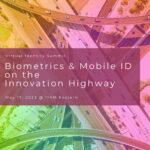

Precise Biometrics has established itself as a world leader in supplying fingerprint algorithm software. The company has also proven adept at maneuvering to navigate the market changes that have ensued, from the dramatic rise of smartphone-based fingerprint sensors to that market’s saturation to the expansion to multimodal capabilities.
Precise Biometrics also has a relatively new CEO: Stefan K. Persson, who took the helm last August at a time of dramatic change in the company and the industry. Persson recently spoke with FindBiometrics Managing Editor Peter Counter in an interview that touched on the company’s expansion to multimodality and other recent strategic shifts – even if fingerprint biometrics remains the company’s “quality stamp.” Persson also discussed what’s to come, including the emerging technology of biometric payment cards, which he said “will take off now,” with Precise Biometrics aiming for numerous pilot programs this year. “That is absolutely a clear trend,” he said.
Read the full interview with Stefan K. Persson, CEO, Precise Biometrics:
Peter Counter, Managing Editor, FindBiometrics: Congratulations on being awarded the position of CEO of Precise in August. What have been some of the highlights of your first six months as the company’s leader?
Stefan K. Persson, CEO, Precise Biometrics: Thanks. I’ve been following biometrics for several years, especially in the fingerprint area because I have 16 years’ experience in mobile phones, and of course I’ve seen how the technology has matured over time.
Momentum is building and so many different industries are using biometrics now. In the past, there has been a lot of discussion about security, but it’s more and more about convenience. Technology is developing rapidly. Even though I’ve been in the mobile phone industry for a very long time and experienced the speed, I’m still amazed and excited by it.
The wide adoption of biometrics started with mobile phones and now it’s spreading into new types of products and industries such as the home area, automotive and wearables like rings and watches. I recently read about a rental car company that is set to use biometrics for their executive customers, they can actually get access to the retal car using their face, with no interaction with staff. In China, you can pay with your face at fast food restaurants and in mobile applications and we also see that casinos are starting to use biometric smart cards for their premium and loyalty customers. I can clearly see it’s happening all over the globe – that’s what has been most interesting for me in my first six months.
Peter Counter, FindBiometrics: Precise Biometrics has a long history in a time when other software providers have either been acquired or gone bankrupt and failed. What do you think the secret is for Precise being able to survive in such a climate?
Stefan K. Persson, CEO, Precise Biometrics: It’s a lot of different things. Firstly, we have investors who really believe in our work. Even if the market wasn’t there, they have continued to invest in us because they believe in the company. Secondly, we have a team that is highly skilled with extremely good and experienced engineers. And thirdly, it’s our product offering in mobile phones, smart cards and what we call new applications. With the shift towards ultrasonic and optical sensors in smartphones, companies are reaching out to Precise because they know that we have extremely good R&D capabilities to handle new technology. We have been in biometrics for more than 20 years and for almost as long, we have been doing fingerprint matching on access control and ID smart cards. The solution we provide for biometric payment cards today is based on that same technology. With our extensive competence in biometrics it is natural for us to apply our technology in new products areas such as wearables, cars and IoT devices. Recently we also decided to broaden our product offering with a solution that combines different biometric modalities providing convenient and secure digital customer onboarding and authentication.
Peter Counter, FindBiometrics: Part of that new business is a shift into supporting multimodal biometrics solutions. Can you tell me a little about the reasoning behind this shift?
Stefan K Persson, CEO, Precise Biometrics: Many companies are working with fingerprint, or face, or voice, or behavior, or iris. But there are very few working with a total system. We realized this and now that I’m on board we have accelerated our plans to develop a platform based on different biometric modalities. In one of our projects we are collaborating with different partners to establish a platform that uses different types of biometrics. Most organizations today offer online applications that require an account or registration in order to access the service. The onboarding procedure varies depending on how sensitive the service is for fraud. Setting up mobile banking for example, usually requires a visit to the branch or credentials sent to a home address while other services require endless personal data. All these ways of account creation are either inconvenient or insecure.
Our solution provides digital onboarding for customers where we carry out identification and verification of the user by using multiple biometrics with other types of metrics acquired from the smartphone. This also enables what we call “continuous authentication” which means the user’s identity is being passively verified in the “background” using biometrics, behavior and for example, geolocation. This requires no action by the user. The point of action is when the user is not authenticated, for example when your biometrics are not recognized or when your behavior deviates. Continuous authentication increases security and improves the user experience of the digital service.
Peter Counter, FindBiometrics: I imagine it would also bring your brand closer to the public and we can expect to see Precise Biometrics having a much higher profile in the future.
Stefan K Persson, CEO, Precise Biometrics: Yes, and we’re moving our marketing activities closer to the end-consumer to tell them about opportunities with this type of technology.
Peter Counter, FindBiometrics: All of this talk about multimodality is fantastic and exciting, but it’s fair to say that Precise is still the leader in fingerprint biometric algorithm software. From your perspective, how has the fingerprint biometric space changed over the past five years, and where do you see it evolving now that we are on the verge of commercial biometric payment cards and in-display smartphone sensors?
Stefan K. Persson, CEO, Precise Biometrics: First of all, it’s important to understand that we will continue to work with fingerprint technology because it has always been our base and is our quality stamp. With this we have the resources to really understand biometrics and will continue to do fingerprint algorithms but in future we will do that much closer to the customer. Most of our customers are based in China and Korea, therefore we are establishing an office in Shanghai to be closer to the daily operations there. In the past, we sent engineers from Sweden to support our customers in Asia, but that was not a sustainable way to do it.
Development is ongoing; you can see that with capacity sensors. They are getting smaller and smaller because customers need to decrease material costs in order to make end products cheaper. Today fingerprint sensors are used mainly in high-end and mid tiers. Reducing materials costs means there is greater opportunity to attack the entry segment of mobile phones.
Another trend in mobile phones is under display fingerprint sensing. This is driven by two things. One is the visual design of the mobile phone. OEM’s want to avoid cut outs in the display for the fingerprint sensor at the bottom and the camera in the front. Sooner or later we will have both the fingerprint and the camera under the display. Another trend is that whole display will be a sensor and I think we will see that by the end of next year. This means you can be continuously authenticated when using your mobile phone. By pressing anywhere on the display, your fingerprint can be verified.
Peter Counter, FindBiometrics: What are the biggest biometric trends that you’ve noticed from the past year overall?
Stefan K Persson, CEO, Precise Biometrics: Smart cards will take off now. That is absolutely a clear trend. It has been discussed for many years and we can see now with the requests we have and with the pilots that are taking place, that it will happen in 2019. We won’t see huge volumes until 2020/2021 though.
I also see that biometrics is going outside the mobile phone and the smart card area, it’s getting closer to other types of applications, particularly those who require KYC (Know Your Customer). And wherever payment transactions or customer dialogues are taking place we’ll see an increase in the use of biometrics. So, the industry is enormous and offers a huge opportunity for all companies working in biometrics.
Peter Counter, FindBiometrics: That goes very well with what we have been seeing in our recently concluded FindBiometrics Year in Review survey. Speaking specifically of Precise Biometrics, what can we expect from you in 2019?
Stefan K Persson, CEO, Precise Biometrics: We recently communicated our new three-pronged strategy that includes smart mobile phones, smart cards, and new applications. Within the mobile phone area we are working more closely with customers in Asia and trying to do it in an extremely efficient way. When it comes to the smart cards, it’s important in 2019 that we run as many pilots as possible and get the first customers up and running to see some real deployments out there. When it comes to new applications, we are heading for a few pilots and hopefully we will be able to sign some new contracts within this area. 2019 will be about getting ready for 2020 and the real take-off for both smart cards and new applications.



![MWC 2019: CEO Stefan K. Persson Discusses Precise Biometrics’ Expansion Efforts [Audio]](https://idtechwire.com/wp-content/uploads/MWC19-Precise-2-card-e1551213340190-150x150.png)



![[SPEAKERS & SESSIONS ANNOUNCED] Banking, Payments, Crypto, Retail: Our Next Identity Summit is all About Financial Biometrics](https://idtechwire.com/wp-content/uploads/FBIO-09282022-FinancialBio-summit-img-scaled-150x150.jpg)
Follow Us